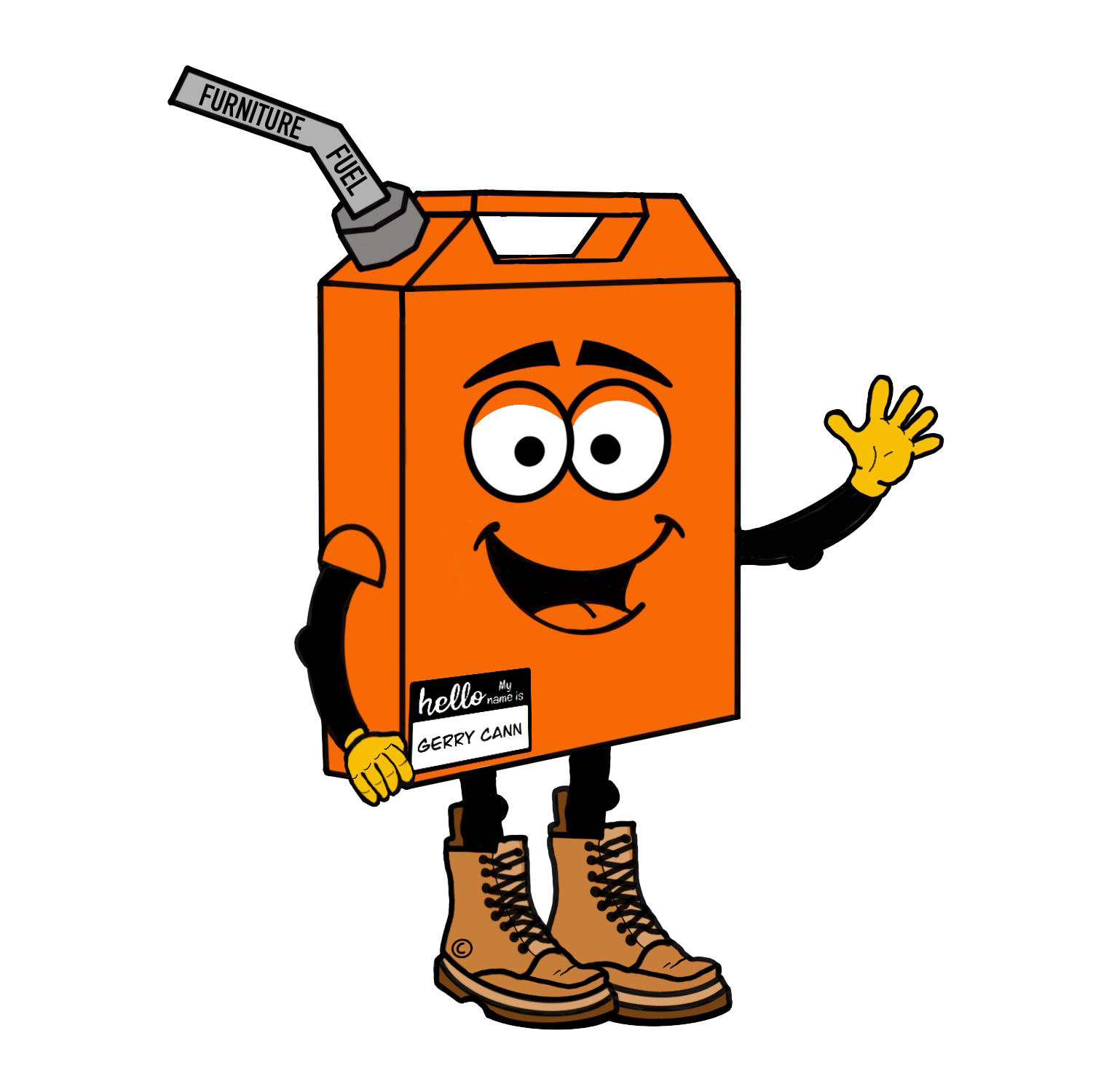How to Identify Key Pages on Your Furniture Website
Jack Young
- Last Updated: 1 September 2025
Table of Contents
TL;DR - How to Identify Your Furniture Website’s Key Pages
Key pages are important website pages—such as homepage, product, category, landing, and blog pages—that drive your furniture business goals through traffic, conversions, or strategic value. Use tools like Google Search Console and SEO software to identify and prioritise these pages, alongside your own business knowledge. While engagement metrics like bounce rate and time on page provide useful user insights, their influence on decision-making has weakened. Align your key pages with search intent to maximise both traditional SEO and AI-powered search performance, helping you reach the intended audience. Decide whether to optimise existing pages or create new ones based on keyword research and user intent. Continuously monitor and align pages with evolving search trends to maximise performance across both traditional and AI-driven search.
Why Identify Your Website Key Pages
In the competitive world of online furniture sales, prioritising the right pages can make or break your business. By focusing on these high-impact pages, you can optimise your time and resources effectively, ensuring your efforts lead to the greatest rewards. That’s why identifying key pages isn’t just a part of keyword research—it’s a vital part of any strategy that deserves its own spotlight.
What Are Key Pages on Your Website?
Key pages, or as we often call them, V.I.Ps (very important pages), are pages on your website that are important for achieving your business goals. This can include pages with high traffic, high conversion rates or of strategic importance.
These pages are the workhorses of your website. Knowing what pages to prioritise allocates your time to where it matters most. To reach their full potential, key pages must have a strong technical foundation, ensuring they are mobile-friendly, fast, and easily discoverable by search engines.
What you classify as a key page will vary depending on your specific business and goals. This is something you must remember when doing competitor analysis. Analyse a competitor’s key pages, but do not copy. Their goals may differ from yours.
So, what makes a page a key page? They could be pages that have,
- High Traffic: These pages attract a significant amount of organic traffic (visitors from search engines) who are potentially interested in your products or services.
- High Conversion Rates: They convert visitors into paying customers or leads, depending on your business goals.
- Strategic Importance: These pages might not have the highest traffic, but could be strategically important for your business, for example, products or services you wish to promote.
- High Rankings: They rank well in search engine results pages (SERPs) for relevant keywords, making them more likely to be found by potential customers searching online.
- Strong Click-Through Rates (CTR): Strong click-through rates used to be an indicator of a key page. However, since the rise of AI, particularly Agentic AI, there has been a dramatic increase in zero-click searches.
- Citations in AI Features: Pages frequently referenced or summarised in Google AI Overviews, featured snippets, or “People Also Ask” boxes may be considered key pages, as they can drive both direct and indirect traffic.
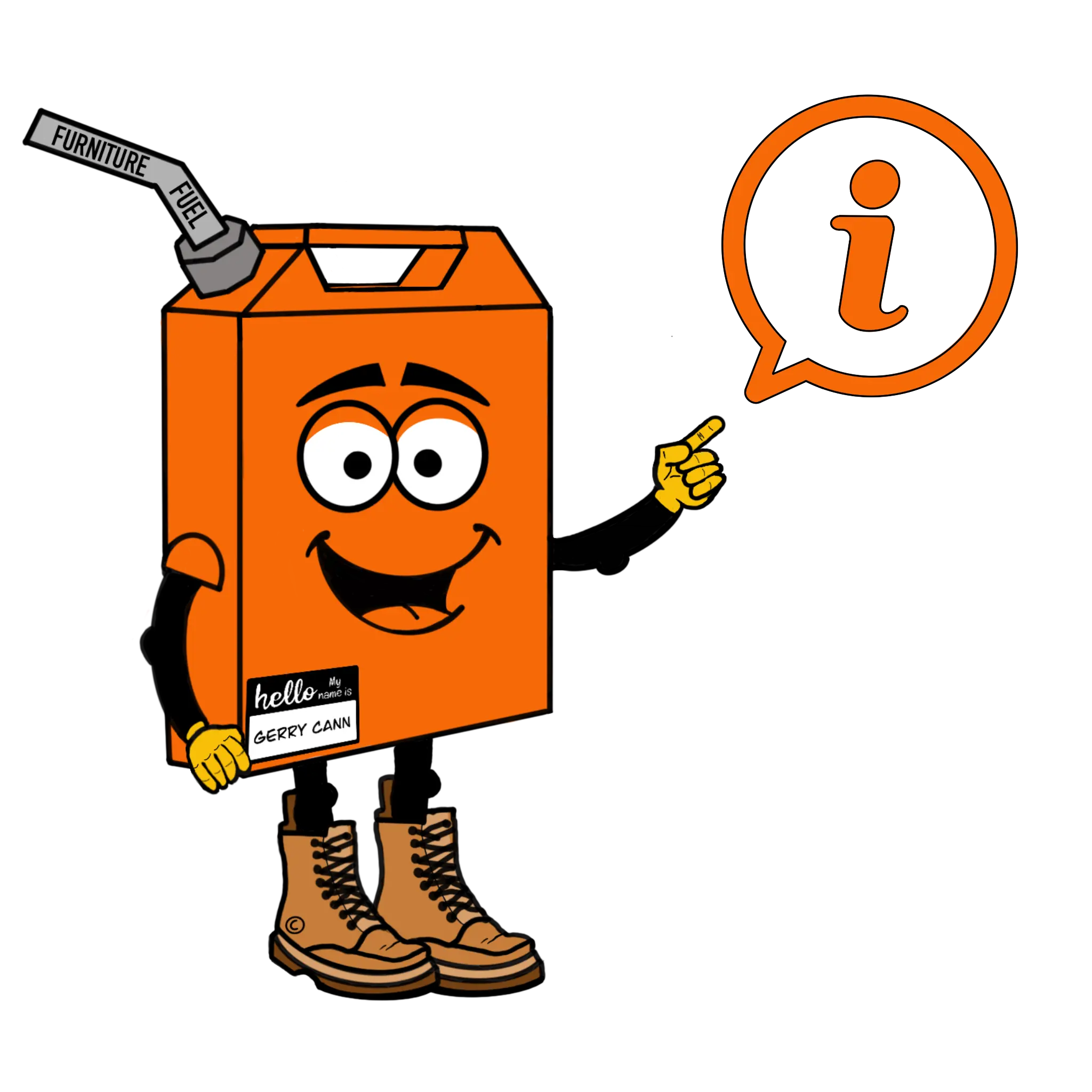
Zero-click searches occur when users find the information they need directly on the search results page without clicking through to a website. This is increasingly common due to AI summaries that provide quick answers. While zero-click searches offer strong brand visibility, they can reduce website traffic, making it important for businesses to optimise content for both search engines and AI to capture any available clicks and build brand authority.
Examples of Key Pages
Homepage
- Function: The main entrance to your website, providing an overview of your products or services. It should be clear and concise and create a positive first impression.
- Optimisation Focus: Strong call to action (CTA), easy navigation, and a compelling introduction to your brand value proposition.
- Example: A furniture e-commerce store’s homepage might feature popular product categories, new arrivals, and offer a Shop by Room navigation menu for targeted browsing.
- AI Note: Ensure your homepage clearly answers who you are, what you offer and why in the opening paragraphs, as this information is often extracted for AI Overviews and knowledge panels.
Category Pages
- Function: Group similar products or services together, helping users navigate and find what they’re looking for efficiently.
- Optimisation Focus: Clear category titles, relevant product listings, and filters to refine searches by material (leather, fabric), colour (grey, blue, brown), and price range.
- Example: A furniture store might have category pages for Sofas, Living Room Furniture, Sideboards, Oak Sideboards, Dining Room Tables, and Outdoor Furniture.
- AI Note: Use clear headings and concise summaries at the top of category pages to increase the likelihood of being cited in AI Overviews for category-level queries.
Product Pages
- Function: Provide in-depth information about a specific item, including detailed descriptions, high-resolution product photos from various angles, dimensions, materials used, assembly instructions, and customer reviews.
- Optimisation Focus: Compelling product descriptions highlighting features and benefits (comfort, durability, storage options), clear calls to action (buy now, add to wish list), 360-degree product views to showcase details, and customer reviews emphasising user experience.
- Example: A product page for a sofa might showcase, in addition to the sofa, its plush cushions, sturdy frame, and available fabric options. It could also include customer reviews praising its comfort and style, along with a clear “Add to Cart” button.
- AI Note: Include FAQs or common questions at the bottom of product pages, as these are often pulled into AI Overviews and People Also Ask sections.
Landing Pages
- Function: Web pages designed for a specific marketing campaign or promotion of a particular item of furniture, collection, seasonal sale, or clearance event. Often reached through targeted advertising or email marketing campaigns. It can also be a lead magnet page for collecting email addresses.
- Optimisation Focus: Eye-catching visuals featuring the promoted furniture collection, persuasive messaging highlighting the offer (discounts, limited-time deals), a clear call to action (shop now, explore collection).
- Examples: A furniture store might create a landing page for the “Athens Oak Furniture Sale” featuring discounted chairs, tables, and lamps. The page would have a countdown timer to create urgency and a clear “Shop the Sale” button.
A landing page for a free guide, “How to Accessorise Your Home,” might highlight the guide’s benefits and include a form for users to enter their email address in exchange for the download.
Blog Posts
- Function: Provide valuable content related to furniture and interior design. This attracts organic traffic and AI citations, establishing your brand as an expert and a thought leader, which potentially leads to furniture sales.
- Optimisation Focus: Informative and engaging content targeting relevant keywords that address user search intent, high-quality visuals (pictures, videos) showcasing furniture pieces in room settings, with internal links to relevant product pages on your website and social sharing buttons.
- Example: A furniture store’s blog post could offer tips on “Creating a Cosy Living Room Oasis”, featuring suggestions on choosing the right sofa, incorporating accent chairs, and using throw pillows for a comfortable and stylish space. The post would include links to relevant furniture pieces featured in the tips.
- AI Note: Blog posts that answer common questions in a clear, structured format (using headings, lists, and concise answers) are more likely to be cited in AI Overviews and featured snippets.
Common Key Pages in the Furniture Industry
Remember, while the pages considered “key” will depend on your specific business goals, there are a few common ones across most furniture e-commerce sites that are highly valuable.
Category pages and product pages are the most important battlegrounds for a furniture business, as they target keywords with high commercial and transactional intent. For example, a search for oak bedroom furniture shows commercial intent. A person may be looking to buy but hasn’t picked a specific product yet. However, a search for Bergen sideboard shows transactional intent, as the user knows exactly what they want and is likely ready to compare options and buy.
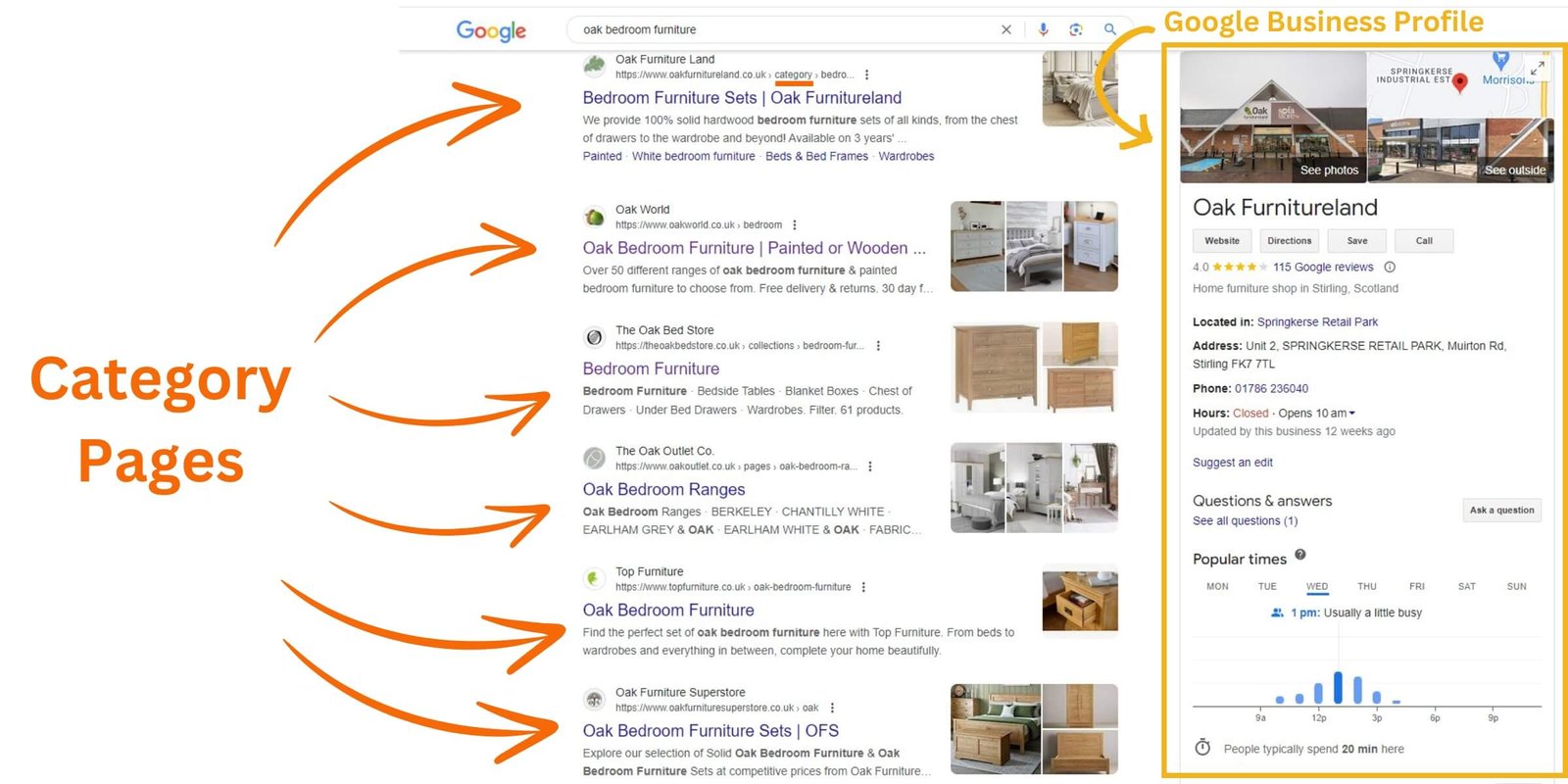
The Image shows results for the search “oak bedroom furniture”. The SERP shows category pages and the Google Business Profile for Oak Furniture land.
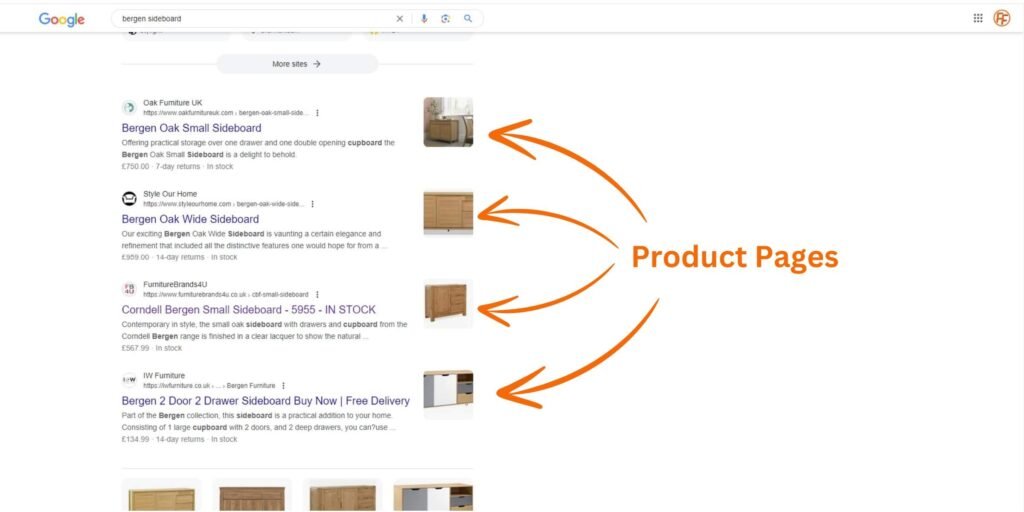
The Image shows results for the search “bergen sideboard”. The SERP shows product pages.
A well-organised website with a clear structure is easier for customers to navigate. It becomes a logical filter system for their brain to follow easily. By grouping your products into logical categories, you help visitors find exactly what they need, from the general (Living Room Furniture category) to more specific subcategories (Sofas and then Chesterfield Sofas), which then lead to the product pages. This improves their experience, which in turn signals to search engines that your site is relevant and helpful
A clear structure also helps search engines and AI. When Google’s crawlers can easily see that your Homepage links to your Category Pages, which then link to your Product Pages, they understand your website’s hierarchy. This tells them which pages are the most important.
By focusing on this logical structure, you’re not just improving your SEO; you’re making your site more user-friendly, which ultimately drives more traffic and sales.
Stay one step ahead by subscribing to our newsletter for ongoing insights and strategies to thrive in the age of AI-powered search.
How To Identify Key Pages on Your Website
Usually, unless there is an urgent need to promote a particular product, the best approach is to identify the current key pages that are valuable to your business first. Improving these pages can often result in them performing better.
Additionally, knowing what pages are currently beneficial to your brand allows you to see if there are any weak links. Are a select few pages doing the heavy lifting for your entire website? What happens if they get affected by an algorithm update? Whilst a complete loss of traffic is rare, your pages could see temporary or permanent ranking fluctuations of your key pages, decreasing traffic to your site.
If your keyword research uncovers valuable search terms that don’t fit naturally with your existing pages, it’s usually best to create new dedicated pages for these keywords. This helps ensure strong relevance and improves your chances of ranking without diluting the focus of current pages.

Algorithm Update Risks: While a complete traffic loss is rare, algorithm updates can significantly impact websites. For example, the March 2024 Help Content Update (HCU) negatively affected many affiliate sites, with some reporting significant or total traffic losses.
Your Business Brain Assessment
You know your business goals. You know your customers. Hopefully, you know which pages deserve the spotlight.
Sometimes, you don’t need fancy tools to figure out what matters most—your intuition about your brand, your products, and the customer journey can point you straight to the key pages that drive sales and engagement.
Sure, data is powerful. But don’t underestimate the power of trusting your gut—it might just be the best “SEO hack” you have.
User Engagement Metrics Assessment
Engagement metrics like time spent on page and bounce rate have long been used to assess how well a page connects with visitors. While their role as direct ranking factors in search engines has never been confirmed, they remain valuable for analysing user experience and content performance.
When a page shows both a very high bounce rate and a low average time on page, it can indicate that, overall, many visitors are leaving quickly without finding what they need. While they are separate metrics, they often tell a related story about user experience.
A high bounce rate combined with low time on page can signal issues such as slow loading speeds, misleading titles, or poor content quality. The opposite, a low bounce rate combined with high time on page, usually indicates engaging, relevant content that resonates with your audience.
Over time, engagement metrics’ influence on decision-making has weakened, particularly as changes in search behaviour, like the rise of zero-click searches, mean they now provide insights for only part of your audience.
Zero-click search means users find answers directly through AI-generated summaries without visiting your site. This has limited the effectiveness of traditional engagement metrics.
This means that a high time on page for one of your blog posts is a strong signal that the content is great and engaging, but it may not reflect the full audience who got the key tips from an AI summary without ever clicking through.
Despite this shift, strong engagement remains important. AI-driven algorithms prefer content that demonstrates user satisfaction and relevance. Pages with clear, authoritative answers are more likely to be cited or featured in AI-generated summaries.
While engagement metrics shouldn’t be the sole indicator of a key page’s value, they still offer vital signals about how well your content meets user needs.
Using Google Search Console (GSC) to Find Key Pages
Google Search Console (GSC) is a powerful, free tool for website monitoring and discovery. It’s also one of the best ways to find your existing key pages.
- Access the Performance Report: Log into your GSC account and navigate to the Performance report from the left-hand menu. This is where you’ll see how your website is performing in Google Search.
- View Your Landing Pages: Click the Pages tab below the main graph. You will see a list of your website’s landing pages and key metrics, including Total Clicks, Total Impressions, Average CTR, and Average Position, if you have them selected.
- Identify High-Performing Pages: Analyse the table to find pages with a high number of clicks or impressions. These are your top pages and are already performing well in organic search.
- Identify Opportunities: Look for pages with a high number of impressions but a low number of clicks. In the age of zero-click search, this isn’t necessarily an issue. It might be a sign that your content is being cited by AI, which gives you valuable brand visibility. However, it also signals an opportunity to capture the traffic that is still available. By improving your page’s title and description, you could make it more compelling and increase your click-through rate (CTR) for the audience that does choose to click, potentially driving more traffic to your website.
- Prioritise and Track: Make a note of these key pages and add them to a spreadsheet to track their performance over time. Pages that are already performing well or are frequently cited in AI Overviews should be monitored closely for ongoing optimisation.
Find Key Pages Using Paid Tools.
While the methods above don’t require paid tools, using them can significantly speed up the process and provide deeper insights.
Paid SEO tools like SEMrush and Ahrefs allow you to quickly find a website’s highest-traffic and most-cited pages. Some of the paid tools now highlight pages that are gaining visibility in generative search, such as those referenced in AI Overviews.
For example, let’s use Ubersuggest, a tool popular with beginners, to look at IKEA’s top pages by traffic.
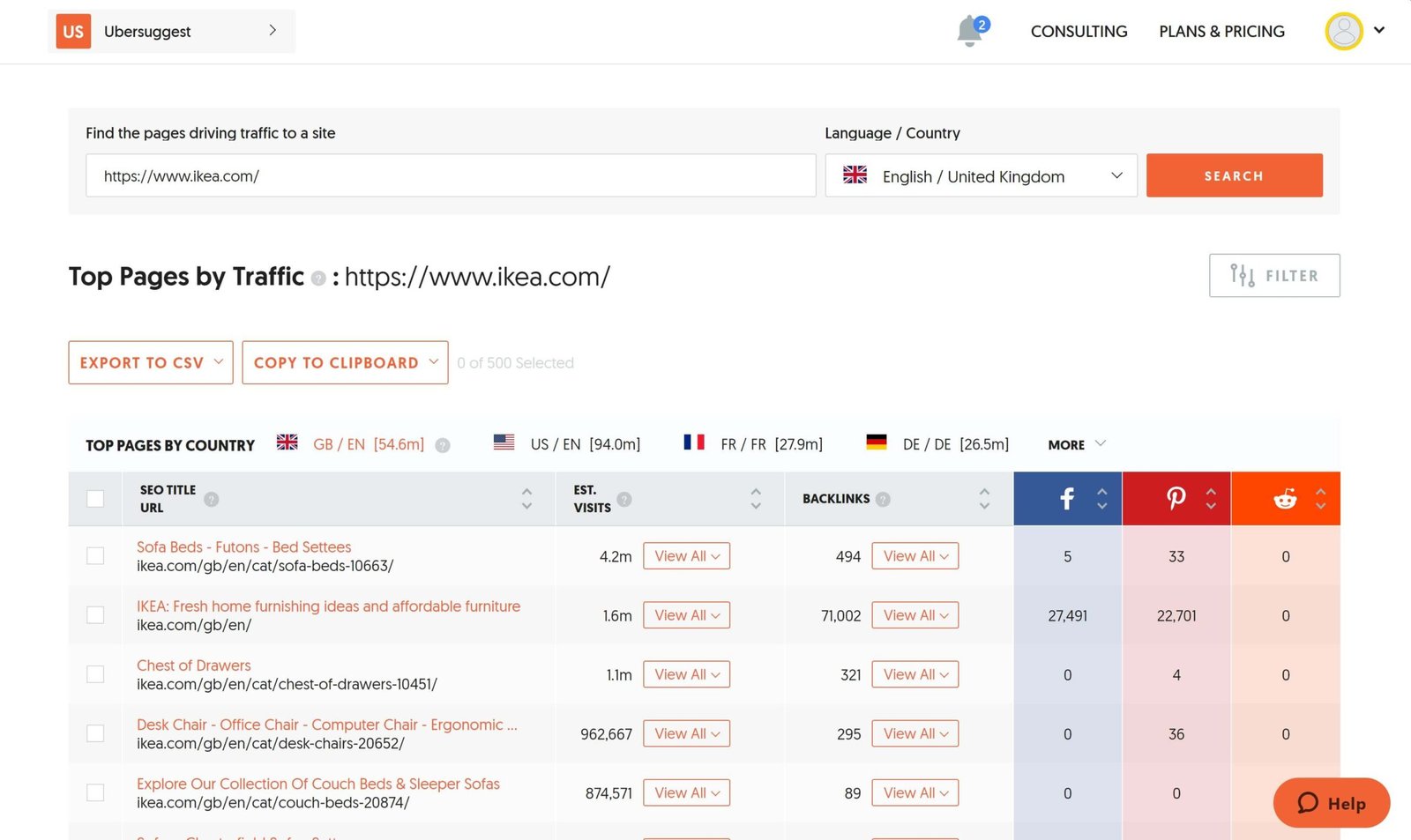
An image showing IKEA’s top pages in the UK by traffic using Ubersuggest.
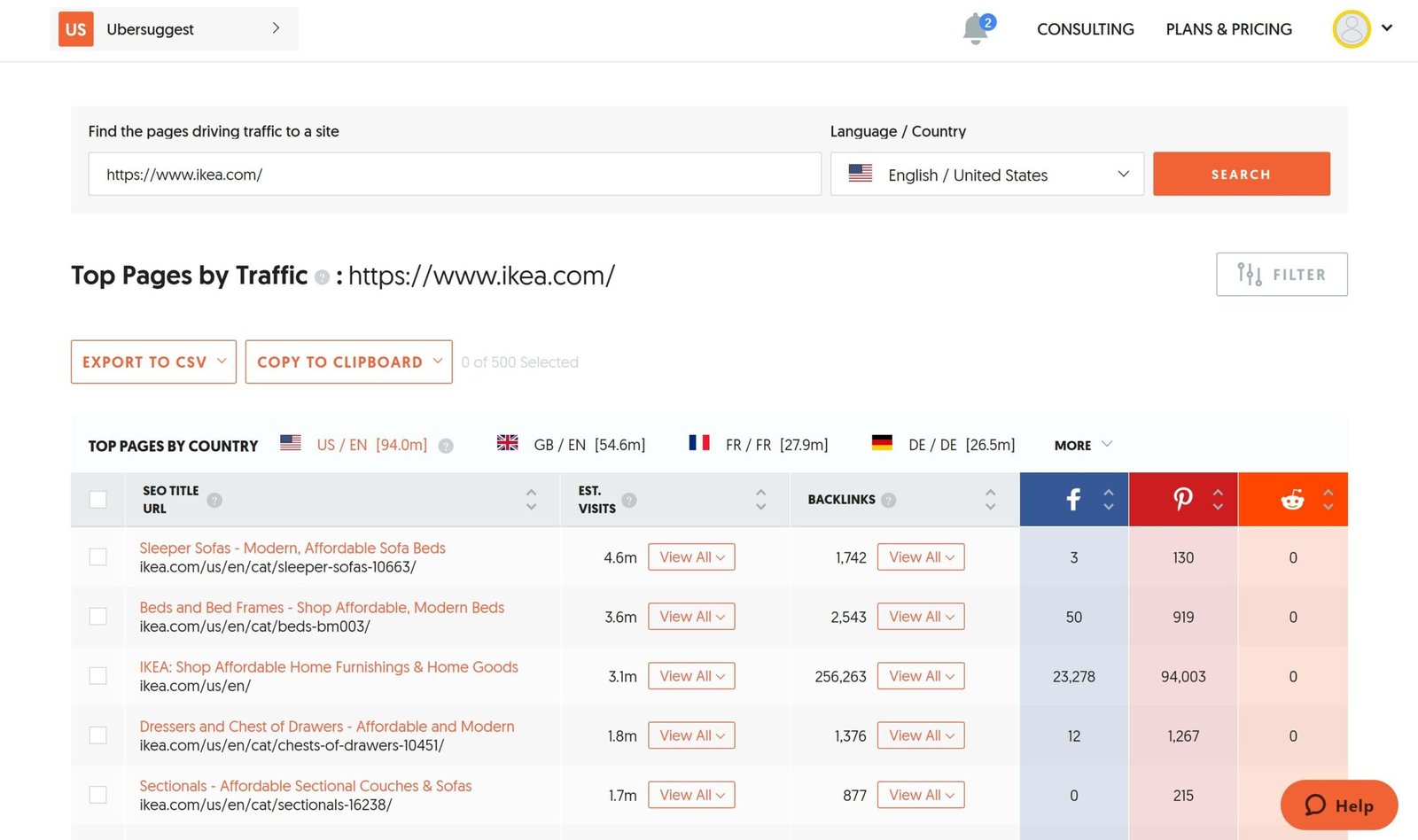
An image showing IKEA’s top pages in the USA by traffic using Ubersuggest.
As you can see, paid tools provide valuable insights that are difficult to find with manual research. Notice how the top-performing page is for “sofa beds” in the UK, but “sleeper sofas” in the USA. This reinforces the importance of localisation, using the exact terminology your customers use in their country or region.
Prioritising Your Key Pages
Now that you’ve identified your key website pages, it’s time to prioritise them. This involves a strategic balancing act, considering key factors:
- Traffic: Pages with high organic traffic form the backbone of your site’s visibility. Prioritise pages consistently attracting relevant visitors. Remember, the quality of this traffic matters just as much as the quantity—make sure the visitors align with your products and goals.
- Conversion Rate: This shows how effectively a page turns visitors into leads or sales. Pages with high conversion rates are especially valuable. Focus on optimising pages that have good traffic but lag in conversions to unlock their full potential.
- AI Citations: Pages frequently cited or summarised in AI Overviews, featured snippets, or related AI-powered features should be high priorities, as they drive both direct and indirect traffic and boost brand visibility.
- Strategic Importance: Some pages may have lower traffic but play a crucial role in your business strategy and campaigns. Examples include:
-
-
- Brand Pages that build awareness through the company story, values, and promote differentiation.
- Informational Content like blog posts on furniture care or buying guides that establish expertise and attract interest, even if they don’t convert immediately.
- Landing Pages designed for specific marketing campaigns, promotions, or lead generation, which might not get high organic traffic but are vital for business goals.
- Brand Pages that build awareness through the company story, values, and promote differentiation.
-
Getting Started
Begin by focusing on pages that rank high in multiple factors—such as strong traffic, good conversion rates, and AI citations—as these often offer valuable opportunities. However, optimise these pages carefully, using data-driven testing to refine without risking their success.
Next, invest in other pages based on how well they align with your overall business objectives, target audience, and market opportunities. Prioritisation isn’t just about absolute metrics but also about relevance and potential impact within your unique context. Remember, this is an ongoing process that should evolve as your site, competitors, and environment change.
The Next Step: Building Authority and Visibility
Now that the key pages have been identified, it’s time to optimise them.
To improve your chances of being cited by AI, you should focus on building an authoritative website and creating high-quality, comprehensive content. This includes earning reputable backlinks, using structured data, and ensuring a great user experience. These are the same factors that Google’s core algorithms prioritise when selecting a source, so focusing on them will improve your performance across both traditional and AI-powered search.
If you are unsure about how to do this, our article on content creation in the Age of AI provides a full guide on these topics. By creating content that is authoritative, trustworthy, and easy for both humans and AI to understand, you’re not just playing the “SEO game”— you’re building a brand that customers will trust and return to.

